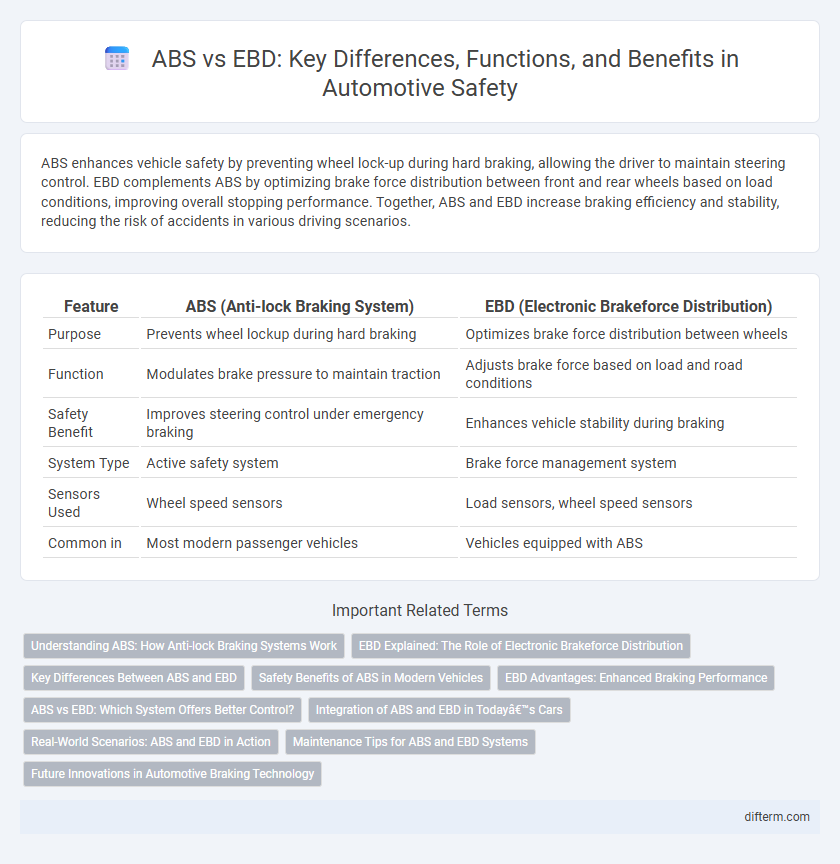ABS enhances vehicle safety by preventing wheel lock-up during hard braking, allowing the driver to maintain steering control. EBD complements ABS by optimizing brake force distribution between front and rear wheels based on load conditions, improving overall stopping performance. Together, ABS and EBD increase braking efficiency and stability, reducing the risk of accidents in various driving scenarios.
Table of Comparison
| Feature | ABS (Anti-lock Braking System) | EBD (Electronic Brakeforce Distribution) |
|---|---|---|
| Purpose | Prevents wheel lockup during hard braking | Optimizes brake force distribution between wheels |
| Function | Modulates brake pressure to maintain traction | Adjusts brake force based on load and road conditions |
| Safety Benefit | Improves steering control under emergency braking | Enhances vehicle stability during braking |
| System Type | Active safety system | Brake force management system |
| Sensors Used | Wheel speed sensors | Load sensors, wheel speed sensors |
| Common in | Most modern passenger vehicles | Vehicles equipped with ABS |
Understanding ABS: How Anti-lock Braking Systems Work
Anti-lock Braking Systems (ABS) prevent wheel lockup during sudden braking by rapidly modulating brake pressure, maintaining traction and steering control. ABS sensors monitor wheel speed and communicate with the electronic control unit to adjust braking force individually for each wheel, enhancing vehicle stability. This technology is crucial for preventing skidding and improving stopping performance on slippery surfaces.
EBD Explained: The Role of Electronic Brakeforce Distribution
Electronic Brakeforce Distribution (EBD) enhances vehicle safety by automatically adjusting the braking force applied to each wheel based on load conditions and road surface. Unlike ABS, which prevents wheel lockup during sudden braking, EBD optimizes braking efficiency by balancing brake pressure to maintain stability and reduce stopping distances. Modern automotive braking systems integrate EBD with ABS to deliver precise control and improved vehicle handling.
Key Differences Between ABS and EBD
Anti-lock Braking System (ABS) prevents wheel lock-up during sudden braking by modulating brake pressure to maintain traction, while Electronic Brakeforce Distribution (EBD) optimizes brake force between the front and rear wheels based on load conditions. ABS enhances vehicle control and stability under emergency braking, whereas EBD improves overall braking efficiency by distributing brake pressure to prevent wheel slip and uneven wear. Both systems work synergistically to maximize safety, but ABS focuses on preventing skidding and loss of control, and EBD targets balanced braking force for improved stopping performance.
Safety Benefits of ABS in Modern Vehicles
Anti-lock Braking System (ABS) enhances vehicle safety by preventing wheel lockup during emergency braking, allowing drivers to maintain steering control and reduce stopping distances on slippery surfaces. Unlike Electronic Brakeforce Distribution (EBD), which optimizes brake force among wheels, ABS actively improves stability and minimizes skidding risks under sudden stops. Modern vehicles equipped with ABS contribute significantly to accident prevention and improved overall road safety.
EBD Advantages: Enhanced Braking Performance
Electronic Brakeforce Distribution (EBD) optimizes brake force between front and rear wheels, improving vehicle stability and reducing stopping distances compared to standard Anti-lock Braking Systems (ABS). EBD enhances braking performance by adjusting brake pressure based on load conditions and road surface, ensuring balanced and efficient deceleration. This technology reduces wheel lockup risk and improves control during emergency braking and cornering maneuvers.
ABS vs EBD: Which System Offers Better Control?
Anti-lock Braking System (ABS) prevents wheel lock-up during hard braking, maintaining steering control and reducing skidding risk, while Electronic Brakeforce Distribution (EBD) optimizes brake force between front and rear wheels based on load conditions for balanced stopping power. ABS enhances directional stability under emergency braking, whereas EBD improves overall braking efficiency by adjusting brake pressure dynamically to varying vehicle loads. Combining ABS with EBD provides superior control by integrating skid prevention with adaptive brake force modulation for safer and more responsive braking performance.
Integration of ABS and EBD in Today’s Cars
Today's vehicles commonly integrate Anti-lock Braking System (ABS) and Electronic Brakeforce Distribution (EBD) to enhance braking performance and vehicle safety. ABS prevents wheel lock-up during emergency braking, while EBD adjusts brakeforce applied to each wheel based on load conditions, ensuring optimal stopping power and stability. The combined ABS and EBD system improves control on various road surfaces, reduces stopping distances, and minimizes skidding risks during sudden braking events.
Real-World Scenarios: ABS and EBD in Action
Anti-lock Braking System (ABS) prevents wheel lock-up during sudden braking, maintaining steering control on slippery roads, while Electronic Brakeforce Distribution (EBD) optimizes brake pressure between front and rear wheels based on load conditions, enhancing stability under varying weights. In real-world scenarios such as emergency stops or uneven terrain, ABS allows drivers to steer around obstacles safely, whereas EBD adjusts brake force dynamically to prevent skidding and improve stopping distances. Together, ABS and EBD work synergistically to maximize vehicle safety by tailoring braking performance to road conditions and vehicle dynamics.
Maintenance Tips for ABS and EBD Systems
Regularly inspect ABS and EBD sensors for dirt, corrosion, or damage to ensure accurate braking performance. Use manufacturer-recommended brake fluids and replace them periodically to prevent system malfunctions. Maintain braking components like pads and rotors in good condition to support optimal ABS and EBD functionality.
Future Innovations in Automotive Braking Technology
Future innovations in automotive braking technology will integrate advanced ABS (Anti-lock Braking System) with more intelligent EBD (Electronic Brakeforce Distribution) to enhance vehicle stability and safety. Emerging systems will leverage AI and sensor fusion to adapt braking force dynamically in real-time, optimizing performance across diverse road conditions. These breakthroughs promise reduced stopping distances and improved control, driving the next generation of smart braking solutions.
ABS vs EBD Infographic

 difterm.com
difterm.com